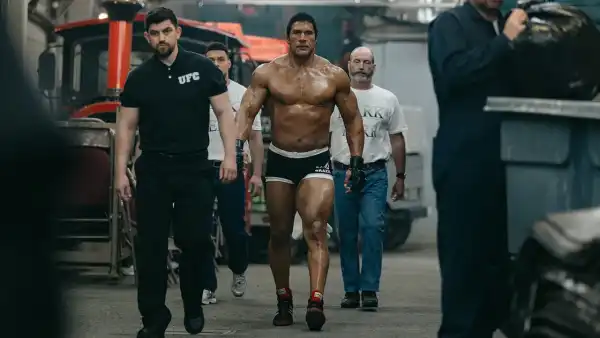
Save this storySave this storySave this storySave this story
Only two varieties of performers are subpar: those incapable of authentic expression and those you’d rather not witness acting. The majority of the remaining ones are poised to excel in pictures helmed by capable directors, and a multitude of performers whose reputations aren’t remarkably artistic have mostly suffered from unfortunate associations. Dwayne (the Rock) Johnson has resided within my personal roster of performers awaiting their moment to truly showcase their talents, ever since his portrayal in Michael Bay’s “Pain & Gain,” from 2013. Subsequently, Johnson has accumulated triumph upon triumph without fully extending his artistry; currently, in the prominent part of “The Smashing Machine,” Benny Safdie’s biopic concerning the former mixed-martial-arts personality Mark Kerr, Johnson undertakes the significant endeavor of animating a remarkable character, by imbuing the role with his own vast persona—perhaps predictably, considering his origins as a professional grappler. It’s a display of panache and exactitude, and bestows emotion onto a screenplay that lacks it.
“The Smashing Machine,” which Safdie both penned and oversaw, depicts Mark (the character, differentiated from the factual Kerr) from the era of his initial contest in the Ultimate Fighting Championship, in 1997, until 2000. The timeline commences with triumphs and increasing renown—although his accomplishments are obscured and menaced by substance-abuse predicaments and discord with his paramour, Dawn Staples (Emily Blunt)—and tapers off with his pivotal downfall in a lucrative competition that owes its considerable monetary stakes to his prior achievements. Safdie’s tactic to the narrative is self-contradictory: as a writer, he adopts an analytical perspective, fashioning scenes that distinctly illustrate the combatant’s capabilities and difficulties and the individual characteristics that contribute to both; yet he films the tale with relaxed documentary-esque sequences and extensive grandeur, neither of which corresponds to the script’s expressive precision.
That’s where Johnson’s enactment becomes pertinent. Ironically, his portrayal derives potency from the constrained concentration of Safdie’s composition, which empowers him to elaborate on the particular attribute, sentiment, or impetus that each scene exemplifies, assembling them akin to fragments in a mosaic to configure Mark’s character. The most captivating of these attributes is exhibited early on, when a reporter interviews Mark following his first victory. As Mark delineates his game plans, his musings swiftly surpass the specifics of the discipline and embrace a philosophical dimension. He commences with the straightforward segment: his requirement to “really impose” himself upon his adversary. Subsequently, he contextualizes victory in psychological terms, articulating, “I’m going to physically assert my will onto” the individual in the ring who possesses the audacity to challenge him: “You genuinely perceive when that transpires, when the person simply relinquishes and utterly diminishes within your grasp.” He portrays inflicting agony in graphic elaboration, and, as though perceiving the ramifications of his own contemplation, states that everything “felt very evolutionary,” a supremely tangential phrase for actions and emotions that he recognizes as primordial and untamed.
Safdie’s rendition of these remarks accentuates Mark’s comprehension of what’s profound, and profoundly unsettling, about mixed martial arts, and possibly all combative disciplines—the directing and commercializing of ferocity. The scene establishes the ambiance for the entirety of the film, yet it’s a pinnacle that Safdie cannot maintain. He conveys a rational movie concerning an irrational subject, an externalized film concerning a narrative of subjective depths. Safdie is evidently intrigued by the fighter’s mindset, yet he doesn’t effectively dramatize the extremity of Mark’s ordeals—except in inverse form, by means of his challenge adjusting into the standards of a noncombatant existence.
Mark dwells with Dawn in uninspired coziness in suburban Phoenix, yet there’s nothing uninspired about the manner he earns his livelihood, and the stipulations that this imposes on his everyday pattern place considerable strain on the couple’s connection; Dawn regards Mark’s athletic vocation as a job, whereas, for him, it’s a thorough mode of living. He declares, prior to another clash, that, to triumph, he must remain “one-hundred-per-cent focussed” or else his “emotions will be running around everywhere,” and some of the movie’s most remarkable junctures—and some of Johnson’s most noteworthy acting—entail Mark’s unwavering focus when occurrences are spiralling out of equilibrium. His domestic existence necessitates established regimens, encompassing precise dietary mandates, and when Dawn procures the constituents of his morning smoothie incorrectly (skim milk instead of whole, half a banana instead of one and a half bananas), he doesn’t rant or even denounce, but calmly discards it and prepares himself another. His uncanny tranquility appears to agitate Dawn even more than an openly emotional confrontation would have achieved.
Dawn (a severely underdeveloped character whom Blunt conjures with sheer actorly vitality) is devoted and empathetic but detached from the absolute, quasi-monastic essence of Mark’s athletic pursuit. (The script never clarifies whether their liaison had been distinct prior to his fighting introduction.) She accompanies him at the gymnasium and aids him in stretching, yet her inability to penetrate the solitude at the core of his pursuit propels her to an imprudent decision that proves pivotal. It conducts to the movie’s most compelling dramatic scene, one that caters to Safdie’s rational proficiencies. When Mark is in Japan to make his introduction on a mixed-martial-arts platform termed Pride, Dawn journeys over and surprises him there, materializing in his locker room at precisely the inappropriate moment, just as he’s readying to enter the ring for a bout. He scarcely acknowledges her presence, placing himself into a tightly governed state of pressurized ferocity so intensely fixated and isolated, detached from all other concerns and thoughts, that she queries him if he’s intoxicated. (In pressing him for attention, she merely fractures his trance and, as the movie elucidates, is partially accountable for his subpar results.) Johnson’s portrayal here is sublime in its simplicity; executing as minimal as conceivable by means of willpower, exhibiting an intense remoteness and an active impassivity, he strikingly evokes an athlete’s competitive self-sublimation.
Johnson emanates a preternatural sensation of constraint throughout, bestowing Mark with a composure that seems sustained with internal bonds of steel that, should one of them falter even slightly, would unleash the infernal rages that he endeavors to reserve for the ring. Back home in Phoenix, when the couple’s connection reaches a crisis peak, Mark proffers a brief but frightening glimpse of the violence he’s containing when not contending. But this is merely a segment in a conundrum; Mark’s attributes get symbolized rather than cultivated. His self-regulation isn’t solely a matter of mind games but also of medication. Along with the imposition of pain, the discipline entails the endurance of pain; to cope, he becomes reliant on opioids, and, following an overdose, attends rehabilitation. Yet the movie exhibits no struggle, no introspection, but, rather, a casually reasonable capacity to discard his stash into a waste receptacle and depart.
The movie proffers so scant of the couple’s existence, so scant of their mutual interests, of their concepts and their observations and their routine discourse, that what is revealed comes across as mere dramatic expediency. The relationships that Mark forms in the progression of his career are similarly simplified—principally, his hearty bromance with Mark Coleman (Ryan Bader), who is initially his coach and subsequently, entering the platform himself, a competitor. This alteration in role appears to possess no ramifications whatsoever in the two Marks’ amity. In public, Mark Kerr speaks amiably about his coach turned rival and even escorts him along for a boisterous impromptu meet-and-greet, but the deficiency of discord comes off less as a token of his imperturbability than of Safdie’s apathy to scrutinizing a friendship beyond buddy-comedy profundity. Mark’s bond with another coach, Bas Rutten (portrayed by the factual former grappler and broadcaster Bas Rutten), is similarly superficial.
As for the discipline itself, Safdie illustrates it capably but impersonally. The fight scenes display mere inquisitiveness about the discipline but no zeal for it or perception into its inner dimensions. They’re informative but not emotive, lacking a sense of wonder or horror or any other extreme sensation; they simply document the strategies, details, and outcomes, without even analytical fascination. “The Smashing Machine” doesn’t ponder the specifics of mixed martial arts, such as its discrepancies from Olympic-style wrestling (where Kerr obtained his commencement) or from the tightly formatted, quasi-balletic methods of boxing. One swift sentence, in which an elderly woman recognizes Mark’s sport as one that was threatened with a legal prohibition, suggests both its controversy and its singularity, but the subject is dropped as casually as it’s mentioned. Safdie adopts a narrative of ardor and fury, of ire and suffering, and diminishes it to the arm’s-length mode of the interesting. Solely Johnson’s dedicated, precise, and vigorous enactment suggests the potency that inherently surges through the narrative and that the movie abandons nearly unexploited. ♦
Sourse: newyorker.com







